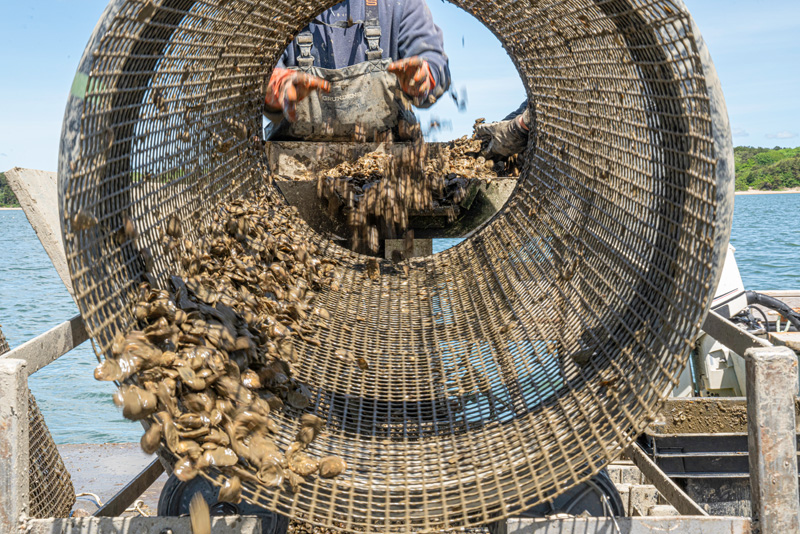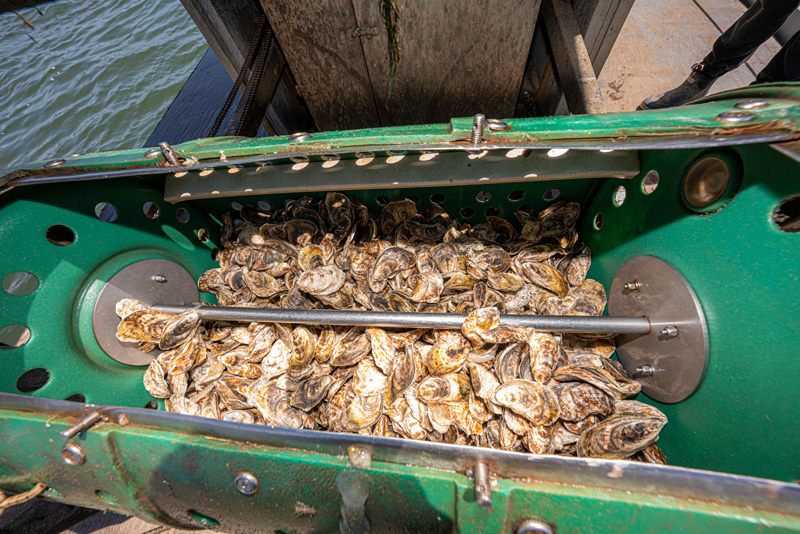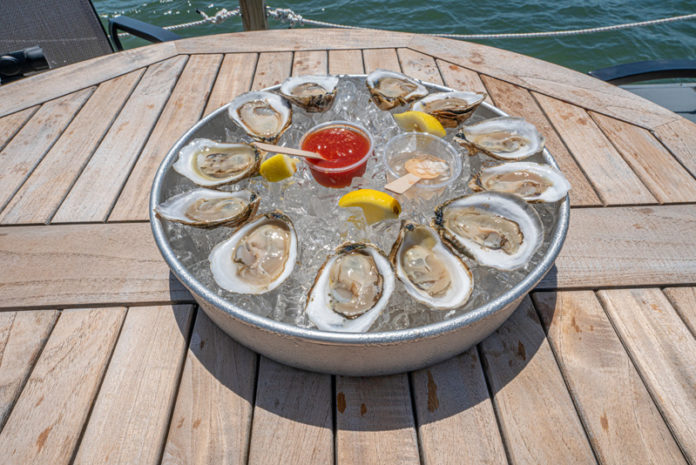For a kid raised living and working on the water, Ryan Smith is in his element at Signature Oyster Farm. He founded the shellfishery in 2006, his own sustainable, generational, commercial fishing business. His father had been a fisherman all his life. Ryan watched his dad move from fishery to fishery as one species became overfished; the money would dry up, and he would be forced to move on to another. “Mother Nature just can’t keep up. When the money is good, everyone wants to do it,” Ryan said.
Ryan had the opportunity to buy one of 12 one-acre oyster farms in Katama Bay: “I could see the writing on the wall … and my father advised me that aquaculture could be a form of sustainability for fishermen.” What his father may not have foreseen was the community that came with oyster farming. Early on Ryan was given real information, hard-learned lessons, by other oyster farmers. It is well known that no commercial fisherman is going to give complete and honest information to anyone competing for the same fish — “In commercial fishing, everyone lies,” he said. In aquaculture, Ryan found not only sustainability, but also a sense of peace. Things were good enough that Ryan’s father got his own farm, which also operates under the Signature Oyster Farm brand. His father eventually “aged out” of oyster farming, and that farm is now owned by Ryan’s wife Julia, the only current female oyster farm owner in Katama Bay.


Protected by Edgartown Harbor and Chappaquiddick Island, this coveted location produces some of the best oysters on the planet. Before the pandemic brought everything to an abrupt halt, Signature Oyster Farms was shipping 30,000 oysters per week to restaurants and fish markets near and far. But the oyster business was absolutely devastated by the closure of restaurants in the early days of the pandemic. Their sales crawled to a near stop before they were able to rethink their distribution model and offerings. ”We had a week where I think our only order was one bag of 20 oysters,” Julia said.
Oysters have a window of time in which they are most desirable, and are grown from tiny seeds to the two- to three-inch delicacies seafood lovers worldwide crave. It takes more than a year for the oysters to reach an optimal size and shell strength. The oysters will continue to grow if they are not harvested; however, once they are too large, they lose a lot of their value. Ryan and Julia were forced to get creative, and along with reconfiguring distribution, they began offering oyster tours.


After bringing some friends out to see his operation, those friends suggested they should offer tours to the public. “They absolutely loved it,” Ryan said. Cottage City Oysters in Oak Bluffs had previously been offering tours, but he was not sure if the concept was for him. Ryan describes himself as “not a talker — my wife can talk, I’m not the one.” I can assure you, though, that once he starts talking about oyster farming, Ryan lights up, and has a wealth of information on the subject that he is more than willing to share.
Ryan built a custom boat for the oyster tours, a large platform with a teak table and chairs that motors tourgoers from the Katama boat launch through the horseshoe of oyster farms in Katama Bay to their farm. They started bringing people out to see their oyster farm, to witness some of the work that goes into farming these magical bivalves, and of course eat some of them. “Everyone loved it … we had a lot of repeat customers … I had people that went out five, six times last year,” Ryan told me, and I can see why.
Each farm has a large floating platform where the oyster farmers care for their farms. They are all unique, and Signature’s is totally custom. “Every piece of machinery you see out here was engineered and built by Ryan,” Julia says. Ryan jumps in with a quick reminder that his father helps him with the welding, one of many demonstrations of his humble character. The equipment all runs off batteries that are powered by a nearly perpetually spinning wind turbine.


The process is fascinating, with each oyster being carefully watched over throughout its journey. From the time they are brought to the farm as seed to the time they are ready for consumption, they are sorted, evaluated, and redistributed throughout the farm. The smallest oysters start in warmer, more shallow water, with higher salinity and plenty of tidal movement. As the oysters grow larger, they are moved into deeper, colder water on other parts of the farm. The oysters are sized several times throughout their life, using a custom tumbler, then placed carefully in flat mesh bags and into large cages that hold the bags in place, seven layers high. Water flow and space for the oysters to spread out is important to oyster farming, as oysters want to grow in large clusters. This makes them very difficult to open and eat, and can also starve oysters that get stuck on the bottom of a pile. Although the bottoms of the cages are weighted, tidal movement can easily disturb one or more of these cages, so each one is carefully monitored. Ryan has a simple saying that sums it up nicely: “More flow, more grow, more dough.”


A visit to the oyster farms offers much more than just oysters. All of these cages housing oysters on these farms have created what can only be described as a reef. “We created [a] habitat for fish; some are important fish to commercial fishermen,” Ryan told me. This habitat brings in everything from tiny shrimp to larger predatory fish like striped bass. Ryan even hand-feeds the striped bass through a hole in the deck of the work raft. “I get attached to them,” he said, a far cry from the commercial fishing days of his youth.
What is perhaps most captivating about the experience with Signature Oyster Farm is Ryan and Julia themselves. From the moment they pulled up to the dock, they were brimming with enthusiasm. That enthusiasm is contagious, and long before they began feeding me oysters fresh from the ocean, I felt like I was out on the water with old friends. I’m already looking forward to my next opportunity to go out with them.
You can find Signature oysters on-Island at 19 Raw, the Dunes, and Edgartown Meat and Fish. You will also find Signature Oysters all over the greater Boston area. If you would like to find out more about Signature Oysters, or book an oyster tour, head over to signatueoysterfarm.com.


